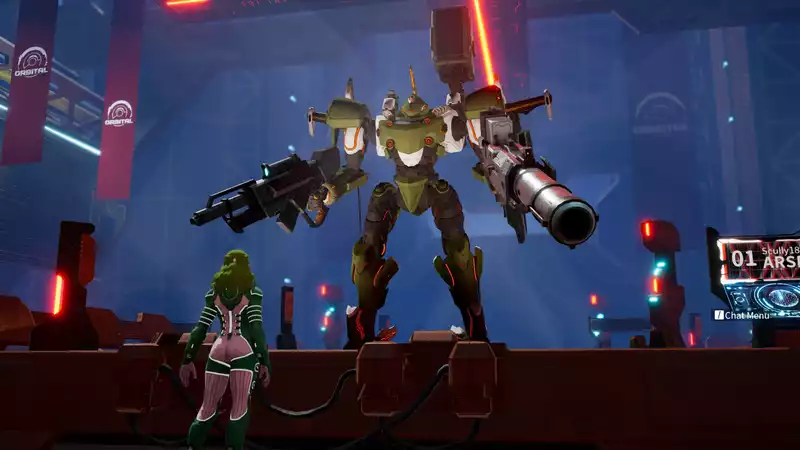The third-person mecha blaster Demon X Machina tells the story of a world recovering from a catastrophe. The moon crashed into the planet and the resulting wreckage released a strange energy that not only awakened all artificial intelligences, but turned them against humanity. As luck would have it, this radiation has also enhanced the abilities of many civilians, including your character. You have decided to offer your services to help defeat the ever-growing AI robot threat through the tried and true method of fighting with large mechs.
After designing an unnamed mercenary in one of the creation suites, you take on missions in the hub area and customize your mech. As you accept missions, you will see cutscenes of other mercenaries discussing the story. Plot is one of the main issues of the game, especially in the beginning, where each new mission introduces a new pilot.
There are over 30 other mercenaries in total, and when you are introduced to all of them, you are also expected to remember them and their unique personality traits when they reappear 10 missions down the road. Of course, not all mercenaries are that important to the overall story, and notable mercenaries will come to the forefront as the game progresses, but there are a great many names and faces to familiarize yourself with early on.
Fortunately, it is the combat that matters, and "Demon X Machina" plays an interesting mech 'em up in that regard. Its pedigree is unmistakable. The producer is Kenichiro Tsukuda, who worked on the "Armored Core" series. The mecha design is by Shoji Kawamori, who has been creating mecha since the beginning of the "Macross" series in the early 80s.
"Demon X Machina" is so familiar that it will appeal even to those inexperienced with mecha games. Tapping the jump button toggles flight on and off, the trigger controls various weapons, and the D-pad allows the player to switch between various firearms on the fly.
The mech also has a generous aiming assist, so a small group of five or six enemies can easily be taken down by simply pointing the crosshair in the general direction of the enemy. Purists may have difficulty with such support, but since they are riding a giant robot designed for combat, it would be strange if they could not easily inflict death on small fry enemies. As the battle became more and more intense and the sky began to fill with small fry enemies, they were grateful for the help.
With a rig like that, it's easy to run "Daemon X Machina" on the highest settings. The game was fun when it first came out on the Nintendos, but it was locked to 30 frames per second, and when it jumps around at top speeds of 60-200 fps (depending on settings), it's obvious that the PC is the game's true home.
However, Daemon X has its own problems. While the controls are streamlined and easy to understand for beginners, the HUD is a nightmare. It consists of about 20 different gauges that keep track of health bars, ammo, etc. While useful to know that your mech's left arm is slightly more damaged than its right, it can be overwhelming at first and seems at odds with the beginner-friendly approach of the rest of the game.
Again, to reiterate, most of the time spent in Daemon X Machina is spent undertaking a mission, watching a few cutscenes, completing the mission, and then choosing another mission. Of course, the missions are never the same; one minute you may be defending an important building from enemy fire, and the next you may be taking on one of the game's longer boss battles, but the general routine remains the same.
Once it all comes together, this shouldn't be much of a problem. Daemon X Machina may lack an engaging storyline and dynamic mission structure, but the action is interesting enough for fans of giant mech combat and visually impressive. If you like giant, destructive war machines, you'll be able to squeeze some fun out of the game before the formula gets old.
.

Comments